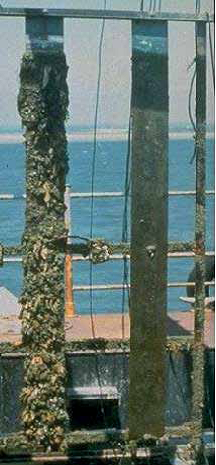 Cathodically-protected and freely-exposed 90-10 copper-nickel after 12 months of exposure.
Cathodically-protected and freely-exposed 90-10 copper-nickel after 12 months of exposure.Biofouling – the adhesion of slime algae, sea mosses, sea anemones, barnacles and molluscs (oysters and mussels) on surfaces of marine structures – can have a strong negative effect on system performance. Biofouling becomes a problem when it places a drag on structures, increases loadings and blocks the inside of piping and condensers. Removing fouling requires expensive cleaning regimes and the application of antifouling coatings.
Steel, titanium, aluminum, polymers and concrete foul readily. While corrosion resistance is the main advantage of copper-nickels, additional benefits can be achieved from their use in lowering macrofouling levels. Slimes (microfouling), however, can form on copper-nickels.
The high inherent resistance to macrofouling of copper-nickels versus other materials is beneficial for marine applications such as boat hulls, sheathing structures, intake screens, sea water pipe work, water boxes, cladding of pilings and mesh cages for fish farming.
This behavior appears to be linked to the inhospitable nature of complex protective films that form on copper-nickel surfaces. Even under prolonged quiet conditions when grasses or shellfish may eventually colonize, these organisms are loosely attached and easily removed by a light brushing or scraping action.
One of the resulting benefits is that the alloys maintain their effectiveness as heat transfer materials in seawater for months between mechanical cleanings, even without chlorination. This benefit can be important for tubing material when saline waters are used for cooling. Optimum results are achieved when the alloys are freely exposed or electrically insulated from less noble alloys, such as steel and aluminum, and when they are free of cathodic protection. To maintain this effectiveness, a freely-corroding state is necessary.
Contents
- Biofouling Development: Attachment of organic matter and marine organisms to materials.
- Biofouling Factors: These include geographic location, season, temperature, type of material, amount of light and distance to the shoreline.
- Reduced Macrofouling: High-copper alloys, particularly the Cu-Ni alloy with 10% nickel (UNS C70600), have low macrofouling properties that can last throughout their service lives in marine environments.
- Microfouling: Copper-nickels have low microfouling, but they are not immune to it.
- Biofouling Removal: Fouling attachments can be wiped away easily.
- Effect on Corrosion: Biofouling enhances corrosion. This is another benefit of low fouling Cu-Ni alloys.
- Effect on Plant Operations: Biofouling can seriously impact the efficiency of marine engineering facilities.
- Applications for Reduced Biofouling: These include tubing systems for handling seawater, cladding ship hulls and offshore structures.
Interactive Presentation
Biofouling resistance of copper-nickel alloys is aslo summarized in Copper-Nickel Alloys in Marine Environments, an interactive presentation.Additional References
References
- Biofouling Resistance of Cupronickel: Basics and Experience, W. Schleich and K. Steinkamp, , Stainless Steel World 2003 Conference, Maastricht.
- Copper-Nickel Alloys for Seawater Corrosion Resistance and Antifouling - A State of the Art Review, C.A. Powell and H.T. Michels, , Corrosion 2000, NACE International.
- Copper-Nickel Alloys Resistance to Corrosion and Biofouling, Powell, C. A. and Michels, H. T., Seminar Technical Report, 7044-1919, , Corrosion 2000, NACE, Original title: The Application of Copper Nickel Alloys in Marine Systems.
